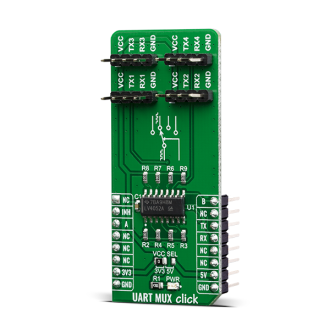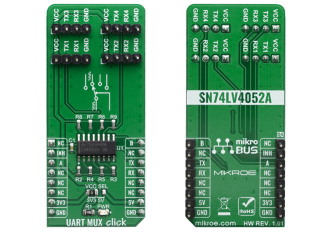
We strongly encourage users to use Package manager for sharing their code on Libstock website, because it boosts your efficiency and leaves the end user with no room for error. [more info]

Rating:
Author: MIKROE
Last Updated: 2019-12-05
Package Version: 1.0.0.0
mikroSDK Library: 1.0.0.0
Category: DAC
Downloaded: 4405 times
Not followed.
License: MIT license
The UART Mux click is a Click board that switches the UART pins (RX and TX) from the mikroBUSâ„¢ to one of the four available outputs. It employs the SN74LV4052A, a Dual 4-Channel Multiplexer and Demultiplexer from Texas Instruments. It is designed for 2-V to 5.5-V VCC operation.
Do you want to subscribe in order to receive notifications regarding "UART Mux click" changes.
Do you want to unsubscribe in order to stop receiving notifications regarding "UART Mux click" changes.
Do you want to report abuse regarding "UART Mux click".


Library Description
The library covers all the necessary functions that enables the usage of the UART Mux click board. User can write, read or check if there is a new byte received on all four channels that are available. Library also offers the functions taht allow user to inhibit or uninhibit the communication.
Key functions:
void uartmux_writeByte(uint8_t input) - Writes sinle byteuint8_t uartmux_readByte() - Read received byteuint8_t uartmux_byteReady() - Checks is there a new byte receivedExamples description
The application is composed of three sections :
void applicationTask()
{
char tmp;
// RECEIVER - UART polling
/*
if ( 1 == uartmux_byteReadyChann1() )
{
tmp = uartmux_readByteChann1();
mikrobus_logWrite( &tmp, _LOG_BYTE );
}
*/
// TRANSMITER - TX each 2 sec
for (tmp = 0; tmp < 9; tmp++)
{
uartmux_writeByteChann1( MESSAGE_DATA[tmp] );
}
Delay_ms(2000);
}
Other mikroE Libraries used in the example:
Additional notes and informations
Depending on the development board you are using, you may need USB UART click, USB UART 2 click or RS232 click to connect to your PC, for development systems with no UART to USB interface available on the board. The terminal available in all MikroElektronika compilers, or any other terminal application of your choice, can be used to read the message.